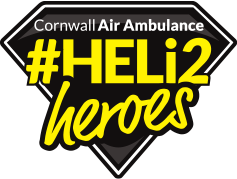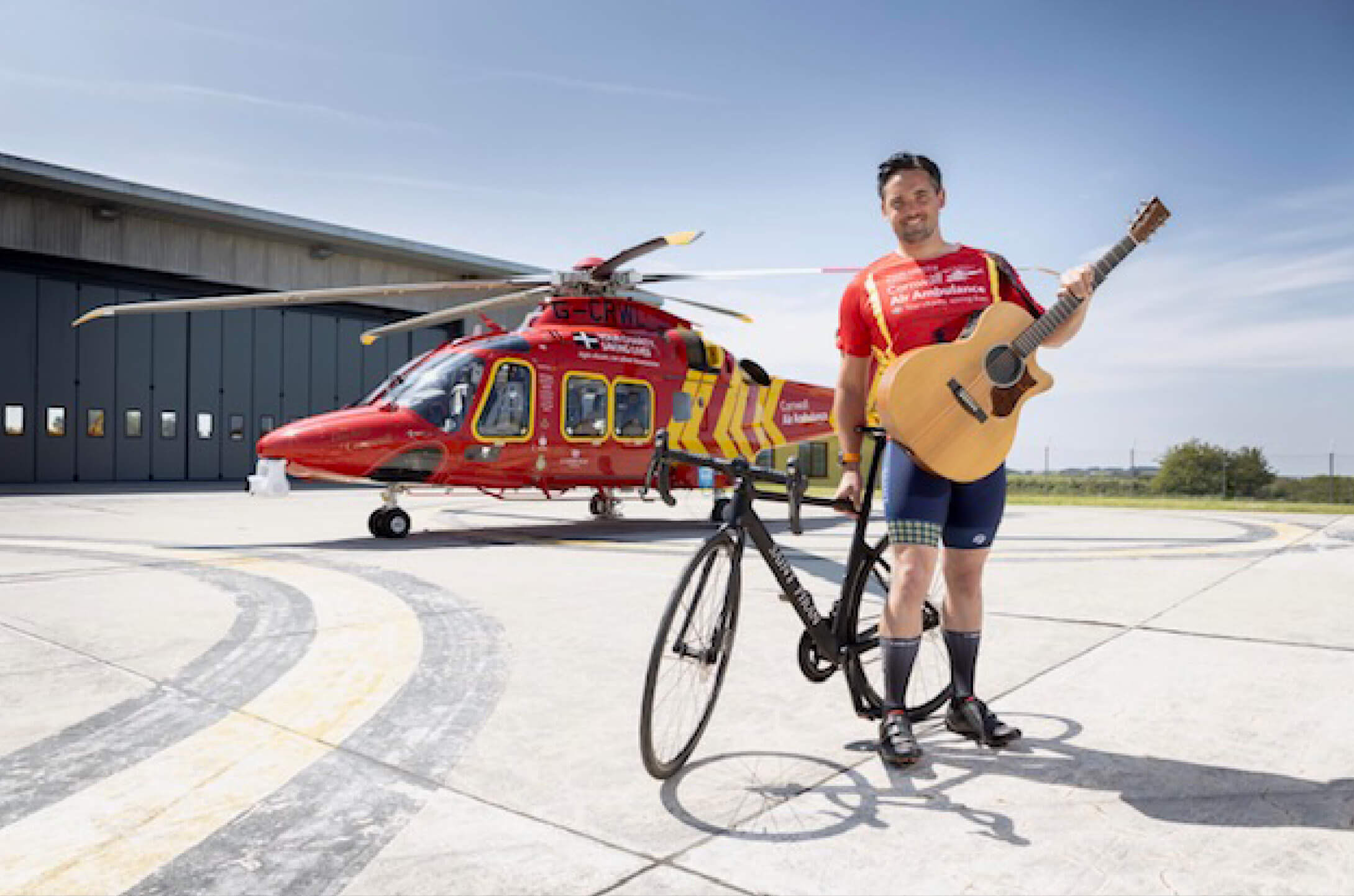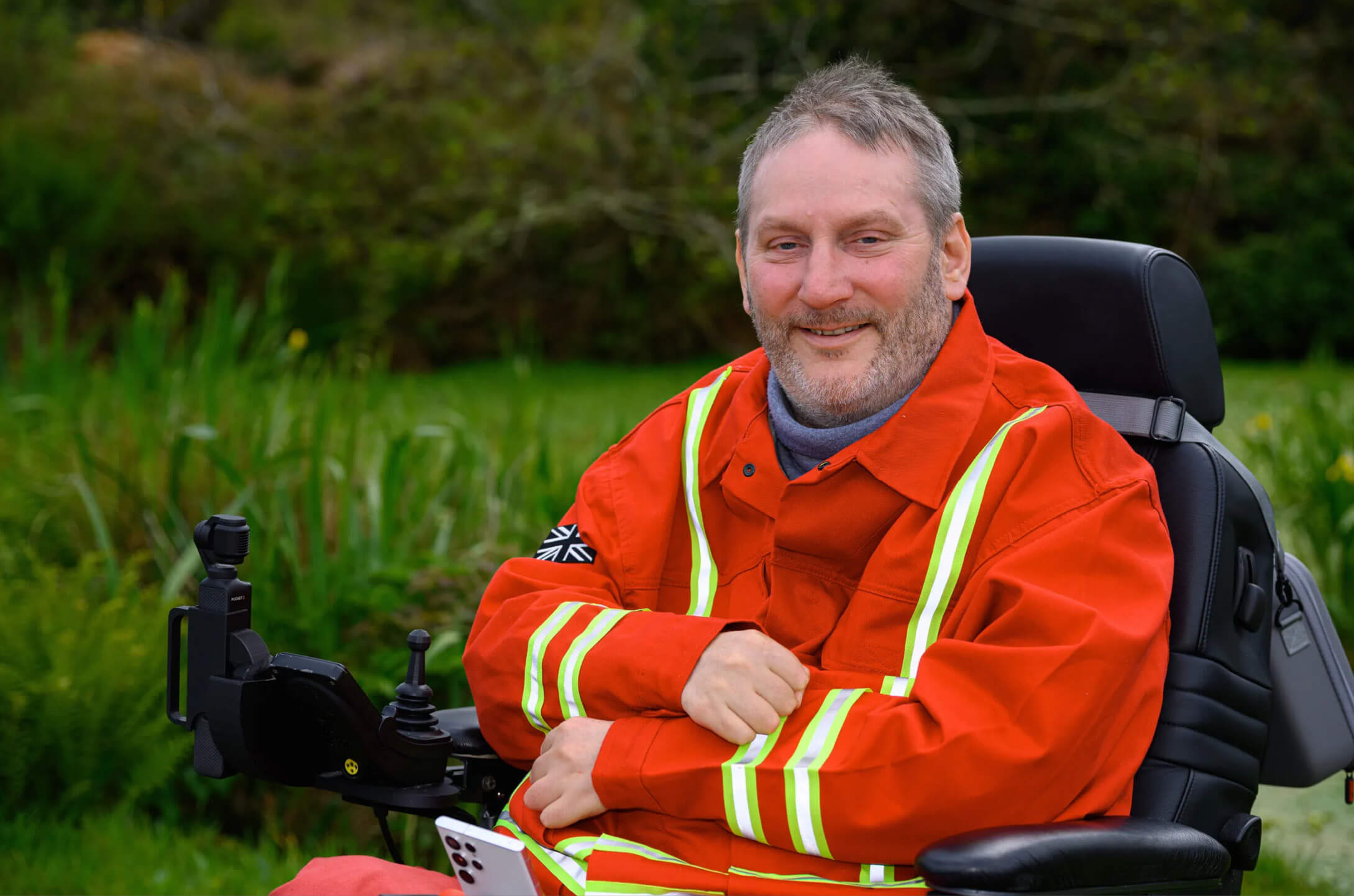Hello
Tim Bunting, Chief Executive
Welcome to our summer digital edition of Airtime, dedicated to the #HELi2 appeal.
It has been an incredibly busy first six months of 2024. Between January to the end of June, your crew were tasked to 525 missions across Cornwall and the Isles of Scilly. 117 of those were in May alone, making it our busiest May on record. June also saw 105 missions, which is a 28% rise on the same month last year. With the busiest summer period still to come, we know things are going to get even busier, putting even more demand on your AW169 helicopter. This demonstrates just how much we need a second aircraft.
Read more
Reaching the £1million mark of the appeal was an important milestone, but we still have a long way to go to reach our £2.85million target. From becoming a Heli2 Hero with your name on the helicopter, to playing the BIG Heli2 Raffle or sponsoring one of the Operations Wing steps, there is a whole host of ways that you can join the mission. I hope you will be inspired by some of the stories featured in this edition.
Thank you to everyone who has supported the appeal so far, we cannot do this without your support. On behalf of all the crew, staff and volunteers here at Cornwall Air Ambulance, we hope you will continue to do everything you can in helping secure your vital second lifesaving helicopter.
Thank you.
Your airtime articles
Heli2 Appeal pass £1million

We’re delighted to announce that our Heli2 appeal, to bring a second lifesaving helicopter to Cornwall and the Isles of Scilly, has passed the £1million mark.
The Heli2 appeal is aiming to raise £2.85m by the end of 2024 to help us secure an additional AW169 aircraft, boosting the resilience and availability of our service.
Karen Hurn, Philanthropy Manager, said: “This is a fantastic milestone to reach halfway through the year and we are incredibly grateful to everyone who has donated so far. There is still a long way to go to hit our £2.85m target and there are so many different ways that you can get involved, from becoming a Heli2 Hero and having your name featured on the second helicopter, to playing our BIG Heli2 Raffle or even funding a mission. By supporting the Heli2 Appeal, in whatever way you choose, you really can make a lifesaving difference.”
With only six months left of the appeal year, there is still a long way to go to reach the £2.85million target.
Find out how you can support the Heli2 appeal and help to bring a second lifesaving helicopter to Cornwall and the Isles of Scilly
A day in the life of a pilot
Pilot Rich Dixon talks us through a typical shift, from morning safety checks, to briefing the clinical crew, analysing flight conditions and how he prepares your helicopter for a lifesaving mission.
The first thing that I tend to do on any shift is give the helicopter a good once over, as you would with your car, to make sure everything is good and its ready to fly. So that’s everything from a general look around, the blades go very fast so I make sure nothing has been hit there and there’s no damage, I make sure all the dampers and controls for the rotors are working. I have a look at the engines on both sides of the aircraft and make sure the oil levels are okay. I’ll check for any damage at the back on the aircraft, checking the oil levels through the sight glasses at the back and on the side. As well as the pilot’s daily checks, the helicopter is maintained by and has regular checks carried out by engineers from Castle Air, our air operations provider.

You’re doing something with a helicopter that ultimately helps people, right now the aircraft is ready to go, in 10 minutes’ time I could be airborne with the rest of the crew, flying off to somewhere I don’t know about yet.![]()
After I’ve finished checking the aircraft over, I have to sign for all the work that I’ve done on it to say the aircraft is ready and fit to fly for the day. After that I check the weather and brief the crew about what we can expect for the day. So we will look at the Met Office charts, and get lots of different detail about wind strength, cloud, visibility and the sea state, that can affect us with things like getting out to the Isles of Scilly or how much time we spend over water. We need to know that the airspace around us is safe, so anything that is happening around us here in Newquay or around the hospitals.
What happens when the red phone rings?
If the weather is fine and we know we can get anywhere, the aircraft will normally be out on the helipad, so I’ll walk out, all the checks have been done, so it’s pretty much ready to turn the batteries on and start it up. During that start up process is normally when the rest of the crew join me, I’ll find out where the job is, and we’ll head off from there. Usually, it’s around five minutes from the phone going to being ready to lift. If the weather is poor, I’ll chat to the crew about what the most appropriate means of getting to the patient is.
The other high-tech piece of machinery I get to play with is the tractor, which we use for towing the helicopter in and out of the hangar. That’s how we move the helicopter around and about as we need to.
Other things that I’ll do during the day, I’ll be keeping an eye on the weather and if anything changes with that, I’ll look at any sort of training that we might need to do as a crew. We cover 19 hours a day, so that is broken into a day shift and a late shift, so in the afternoon I’ll be getting things ready for the late pilot to come on, so if the phone goes at shift handover time, then the new crew are ready to go and the information they need is ready. And from time to time, I do have time for a coffee as well!
We’re currently fundraising for a second helicopter, which is a first for us. Owning two AW169s will mean there is no longer a need to lease a smaller backup aircraft. For the team of pilots, always flying the same type of aircraft is much safer for us, and it means that we’ll always be operational on the best suited helicopter type for our crew and patients. It’s a really exciting time to be a pilot at Cornwall Air Ambulance.

Play the big heli2 raffle
To mark a very special year here at Cornwall Air Ambulance, we have launched the BIG HELi2 Raffle.
We are giving you, our dedicated supporters, the chance to win a top prize of £2,500, along with 12 other cash prizes, including a second-place prize of £500 and a third of £250.
Not only do you have the chance to win big, but every penny raised from entries will go directly towards the HELi2 appeal.
The raffle closes on Friday 20th September and will be drawn on Friday 27th of September 2024.


Become a heli2 hero - like davey
Davey Shephard was popping to the shop on his motorbike in Callington one evening, when he was involved in a serious road traffic collision that left him with life-changing injuries.

“If Cornwall Air Ambulance wasn’t there I probably would have died. I have a little girl, and I’m grateful that I’m still here to be a dad for her.”
Critical Care Paramedics Pete Storer and Paul Maskell were tasked to help, onboard your AW169 helicopter. At the roadside, the crew administered ketamine so they could stabilise and splint Davey’s arms and his leg. There were concerns that he may need a blood transfusion due to blood loss.
After being treated on scene, Davey was airlifted to Derriford Hospital where he spent two weeks in a coma.
As well as suffering from spinal injuries and broken arms, Davey had broken his coccyx, had blood clots on the lungs and had to have his right leg amputated below the knee. He has had to learn how to walk with a prosthetic leg and recovery is still very much underway.
Davey has now been back to Cornwall Air Ambulance HQ to meet Pete and Paul again and thank them in person.
Davey has also signed up to become a Heli2 Hero, meaning his name will feature within the chevrons on the base of your second AW169 helicopter.
“I want to help others really; I never want others to not be able to get the help they need. I’ve given another donation as well and I’ll do my bit really. My little girl is lucky I’m still here, and I wouldn’t want anyone else to lose their dad, or siblings or family members.”
If you, like Davey, would like to become a #HELi2 Hero and have your name, or the name of a loved one or community group, featured on your second AW169 helicopter, visit the Heli2 area today.
Meet John Griffin
He is swimming ONE MILLION METRES to raise money for the HELi2 appeal
The 70-year-old is swimming 4,000 metres a day (160 lengths), six days a week, for a whole year to reach the target. And he’s aiming to raise £1million for your charity!
“I’ve worked with air ambulances in my previous existence when I was working in London, I grew up in the Lake District and the air-sea rescue helicopter used to work with the mountain rescue teams I was associated with. Living in a rural community, if you’re off the beaten track you’re not going to get a road ambulance to you quickly, and the ability to get you to hospital quickly in an air ambulance is so important.”
Meet Tom Cary
Cornish country singer Tom Cary is raising money for the HELi2 appeal by taking on a ‘Country across the Country’ challenge.
Tom will be cycling from John O’ Groats to the Isles of Scilly and each evening will stop off to perform a gig at a different pub or venue.
Tom’s challenge will take around 20 days to complete with 20 different gigs along the way.
“As soon as you mention Cornwall Air Ambulance to somebody, they love it. And Cornwall being the first one in the country is pretty special. It was a no-brainer to support the charity, I’m a big advocate for water and coastal safety, that coupled with the fact I’ve spent a lot of time in the sea, rowing, swimming and surfing, I’ve seen them go out on calls numerous times and it’s incredible to actually watch it. It’s almost like an invisible safety net that people have here in Cornwall, and they know it’s there, it’s that mental security knowing that it’s there.”
Meet Steven Webb
Airlifted patient Steven Webb is embarking on a 500-mile coastal challenge in his wheelchair to raise money for the HELi2 appeal.
Steven was left tetraplegic following a swimming pool accident in 1991. Cornwall Air Ambulance airlifted him from Truro City Hospital to a specialist spinal unit in Salisbury for emergency surgery, saving hours of vital journey time which he believes saved his life.
Now Steven is aiming to create the first inclusive route all around the Cornish coastline, ‘The Cornwall 500’, to enhance accessibility.
The challenge will take around 20 days, and he plans to cover around 25-30 miles of the Cornish coast each day.
And as a dedicated supporter of your charity, he is hoping to raise £20,000 along the way.
Voices of Cornwall
A new album which showcases local Cornish artists is also raising vital funds towards the second helicopter.
Voices of Cornwall volume III is titled ‘en-sol’, which means ‘arise’ in the Cornish language.
The recording features a collection of contemporary Cornish musicians, and artists with Cornish connections, spanning a range of different genres across 19 tracks.
You can purchase the album HERE
Coming soon to a runway near you!
Our fantastic running challenge, Runway Runaround, is returning – and you and your family are invited to take part!
Runners are invited to sign up for the event on Saturday 19th October 2024 at Perranporth Airfield to help raise money for your charity.
There will be two runs happening on the day, the first is a 2.5K circuit for children up to 16 years old where we encourage fancy dress. One parent can run with their child at no additional fee as they make their way round the runway in one giant fun run. It will then be followed with adults (over 16s) taking to the runway for a 10K loop, fancy dress is optional but encouraged.
Alongside the run, there will also be a DJ playing live music, children’s rides and an onsite café serving food and drinks.
Entry fees and any additional fundraising will help to raise vital funds, enabling the crew to keep flying and saving lives across Cornwall and the Isles of Scilly.
Join us on the starting line and sign up today.

Critical Care Paramedics undergo helicopter simulator training for the first time
Being a helicopter pilot isn’t an easy job (despite what they might tell you!). It requires numerous qualifications, a licence, flying hours’ experience and intensive ongoing assessments and training.
Twice a year our pilots must complete scenario-based helicopter simulator training to practice emergency situations, working to identify and solve potential problems that could occur in flight. This involves visiting the official AW169 simulator at the Leonardo headquarters in Italy.
For the first time, the Critical Care Paramedics will also be undertaking this training to further enhance their skills as Technical Crew Members (TCMs).
All of our Specialist Paramedics in Critical Care are qualified TCMs. Sitting on the front left-hand side of the cockpit, this means that they are trained to assist the pilot with navigation, hazard perception and in identifying suitable landing sites.
The first to take on the training was Pete Storer. He said: “As TCMs, it is vital that we are fully equipped with the knowledge of how to handle any sort of emergency situation with the aircraft, if one should ever occur.
“The simulator training allows us to experience these types of emergencies in an exact replica of our AW169 helicopter. The mock scenarios provide the chance to put our knowledge into practice in a safe environment.
“For example, we would be simulating flying to a mission when a training incident will be initiated by the examiner controlling the simulator, with real-time hazard warning captions flashing and audible alerts coming through the headsets. You must identify what the issue is by looking through the emergency action cards and reading them through to the pilot, so they can act accordingly. We ran through scenarios such as an engine fire, engine failure and rooftop helipad landings at hospitals, essentially all the things you can’t normally practice due to health and safety.
“It is hugely beneficial for our learning in terms of safety, and simulating things you can’t simulate at the base whilst working closely with the pilots. But also, it’s to see if there is anything more we can do within our TCM roles and training development pathways for the future.”
Over the course of the year, all the paramedics will be visiting the simulator to further their training.

She would have died without Cornwall Air Ambulance.

15-year-old Holly Martin was riding her horse when she suffered a life-changing fall, leaving her with a severe traumatic brain injury.
Holly’s horse spooked, bolted across the field and tripped. Holly fell, landing on her head. Despite wearing her riding hat, Holly severely injured her head and was knocked unconscious.
Cornwall Air Ambulance was tasked to the scene, with Critical Care Paramedics Mick McLachlan and Martin Bunt onboard your AW169 helicopter.
With concerns about Holly’s head injury, Mick and Martin quickly made the decision to put her under anaesthetic so they could take control of her breathing. Once she was stable enough to travel, the crew airlifted Holly to Treliske Hospital.
Martin said: “It was clear from when we arrived on scene that Holly had suffered a severe head injury. With any kind of trauma to the head it is vital that we get the patient to hospital as quickly as possible for urgent care. Incidents like these are when time really does matter, and thanks to our AW169 helicopter and its fuel load, it meant we could convey Holly from the Lizard to Treliske and then transfer her onwards straight to Bristol.”
At the Royal Cornwall Hospital, Holly had a scan which was sent straight to the surgeons at Bristol so they were ready upon her arrival. Cornwall Air Ambulance then conveyed her from Treliske straight to the Bristol Royal Hospital for Children for onward care, where she immediately went into surgery for a craniotomy.
Holly had suffered a severe traumatic brain injury, hypoxic damage due to a lack of oxygen being supplied to the brain and a small basilar skull fracture. She remained in hospital at Bristol for over a year, a total of 410 days.
Dad Adam, who is a retained firefighter and co-responder in St Keverne, said: “She would have died without Cornwall Air Ambulance, without a shadow of a doubt, she would not have survived an ambulance journey, no chance. If they hadn’t come, she would have died.”
525 missions in the first six months of 2024
Cornwall Air Ambulance was tasked to 525 missions in the first six months of 2024.
212 of those were trauma incidents, 162 were medical related incidents, 141 were cardiac arrests and we also carried out 10 inter-hospital transfers.
May was our busiest on record, with 117 call outs over the course of the month. That is a rise in taskings of almost 20% compared to the same month in 2023.
June also saw a rise in mission numbers, with 105 taskings. That is a rise of 28% compared to the 82 call outs in June last year.
Following a considerable increase in recent mission figures and with the busiest summer months still ahead, we are anticipating demand to rise further.
Adam Smith, Unit Chief Pilot, said: “We know that the summer period is always our busiest time of year, and we’re expecting our mission numbers to rise further as the population of our county increases. This puts extreme demand on our helicopter. More flying hours means more wear-and-tear and more maintenance. Owning a second AW169 aircraft will ensure that when online, our crew will always be able respond on the most capable helicopter, even during those times of planned or unplanned maintenance, we will have a state-of-the-art aircraft ready and available. That will make a huge difference to our operation, boosting the resilience and availability of our service.”



